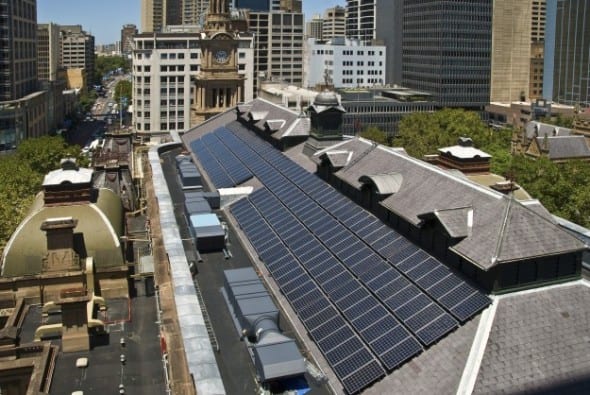The City of Sydney is calling on the Australian Energy Market Commission to change the rules governing Australia’s electricity supply, in a joint push with the Property Council of Australia and the Total Environment Centre to pave the way for more distrubuted renewable energy to be generated and shared on local grids.

Shared energy, which in cities mostly comes in the form of community solar installations, has lately emerged as third type of renewable energy installation – somewhere between rooftop solar and utility-scale – which a recent US report has predicted will grow five-fold in America in 2015, and capture a major market share by 2020.
According to a recent US NREL report, shared solar projects – which are now being subsidised by the Obama government – are expected to open up opportunities for some 50 per cent of current US households and businesses unable to host solar due to site unsuitability, ownership, or multi-unit status.
In Australia, however, the practice – also known as virtual net metering – is not backed by federal government policy, and is more often than not discouraged by what many consider to be outdated electricity market regulations, despite the fact that, as was explained here two years ago, it could solve two critical energy supply problems in Australia – and not just for consumers.
As noted in this story about Australia’s first virtual net metering trial being conducted in the Byron Shire in NSW, the practice “has been advocated… as one means where network operators could dodge the death spiral. Rather than encouraging users to use battery storage to save the excess energy and perhaps go off-grid, allowing virtual net metering means their poles and wires still have some skin in the new energy architecture.”
In a statement on Friday, the City of Sydney, which aims to become energy self-sufficient by 2030 through a combination of trigeneration and renewable energy, said current rules meant distributed generators in the CBD were still charged full network fees, despite delivering excess clean electricity to the grid.
“Under current rules, full network charges are still payable if an office tower with its own generator sends surplus power to the building next door or across the street,” the statement notes. “This fails to recognise the savings made from not using the long-distance networks of poles and wires.”
Under the proposed rule change – a comprehensive 136 page submission compiled by Oakley Greenwood – the group is calling for local generators to get a credit from electricity networks, in recognition of them using only a fraction of the infrastructure – reflecting the saved network costs.
The document notes the fundamental change taking place to the formerly centralised electricity supply chain, in which power flowed in one direction from large centralised power stations over long distances to reach end users connected to local distribution networks.
“An increasing proportion of end users now generate some of their own electricity, and an increasing proportion of electricity flows bi-directionally, especially within local distribution elements,” the submission says.
“However, the incentives for local generation in the current Rules either do not provide adequate recognition of the benefits that local generation can provide, and/or may not be readily accessible to small-scale local generators: and their proposed changes can avoid costly network upgrades, use distributed energy to address peak demand , and … exert downward pressure on prices.”
NSW Director of the Property Council, Glenn Byres, said the proposed change would have major benefits for businesses and all electricity consumers.
“Changing rules to encourage more local power generation will improve energy efficiency, curb emissions and reduce network maintenance costs,” he said.
“It is essential the regulatory environment acts to stimulate innovation and set a platform for the property industry to play its part in building better cities.”
This is not the first time Sydney City’s council has called for a change to the electricity market status quo.
Last year, Sydney Lord Mayor Clover Moore appealed to state and federal politicians to cut the green tape that was discouraging the development of cleaner, locally generated energy in the the CBD.
“The business case for Council, community and business to deliver local energy projects generating local jobs is there,” Moore wrote in an opinion piece published in The Guardian in February 2014. “Unfortunately, the rules governing how we can do this are strangled in ‘green tape’.
“To share energy we need to export it across the electricity grid, but the rules were drawn up years ago for big power stations. They are anti-competitive, increasing our emissions and power bills. We need the help of our state and federal governments to get rid of this crippling regulation.”
With the weight of Australia’s major property industry group behind it, the Council is hoping the AEMC – the body that manages the rules in the national electricity market – will take note.
“For years the City has been pushing for a system that makes it easier for residents and businesses to access clean power that is generated and used locally,” Moore said in a statement on Friday.
“I am very pleased to be working with the Property Council and the Total Environment Centre on this next important step.”
The AEMC is expected to review the joint City of Sydney proposal and consult with industry, business and the community before making a decision.










